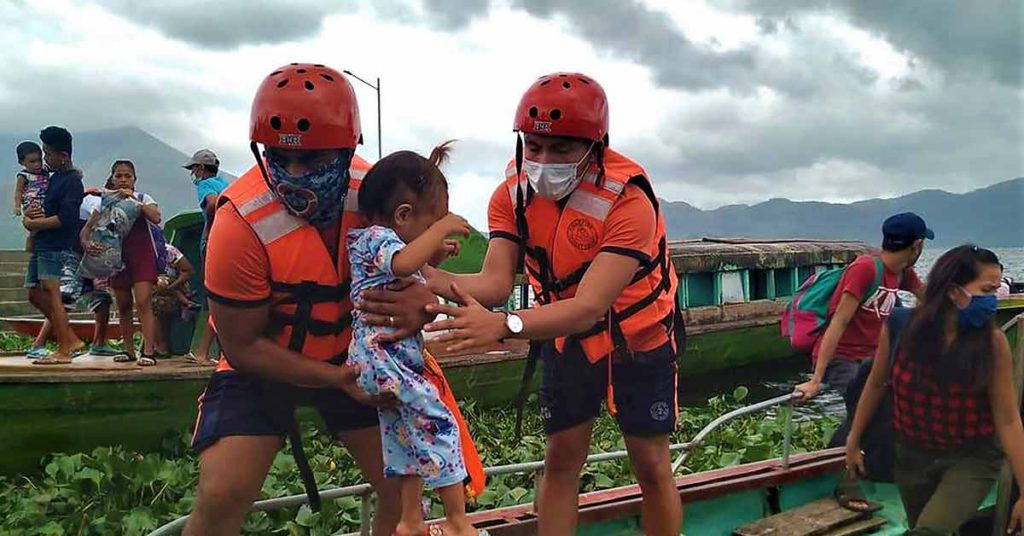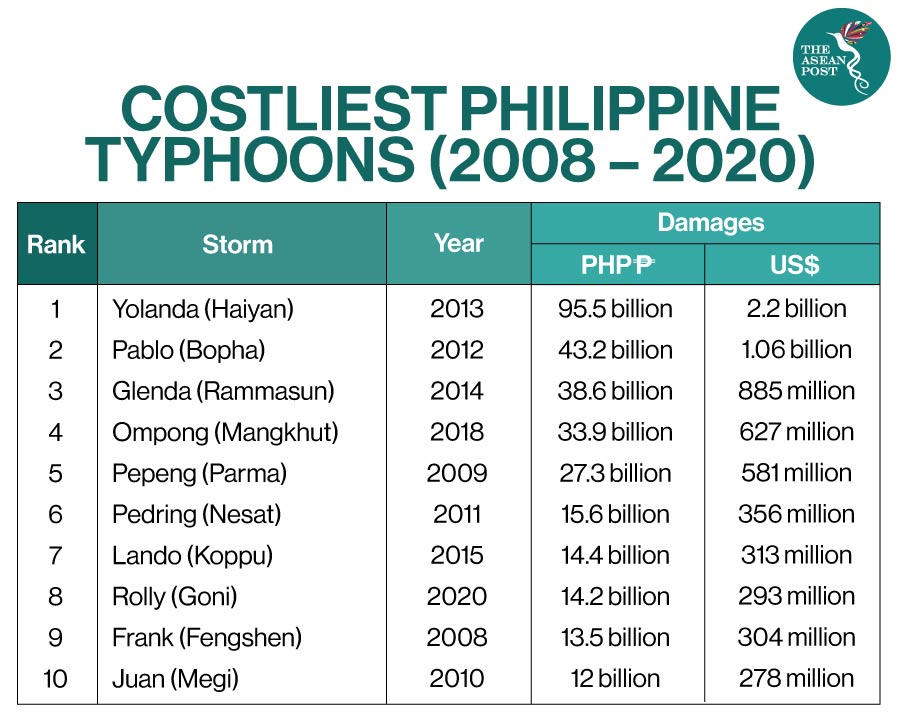
Typhoon Goni, known in the Philippines as Super Typhoon Rolly, was an extremely powerful tropical cyclone that made landfall in the Philippines in the province of Catanduanes, and affected the Bicol region and Southern Luzon. It was thus far the strongest tropical cyclone observed worldwide in 2020 and was one of the most intense tropical cyclones on record.
In the aftermath of typhoon Rolly/Goni, a total of 230, 834 families, or 906,146 persons were affected by the typhoon of which 61,912 families or 228, 559 individuals are served inside and outside of evacuation centers. Likewise, a total of 418 passengers, 183 rolling cargoes, and seven motorbancas (boats) are stranded in various ports in the regions of Calabarzon and MIMAROPA. In terms of casualties, 20 persons died, 165 were injured, and three people are reported missing.
In as far as damage to roads and connectivity is concerned, a total of 60 road sections and seven bridges were affected by flooding, landslides, and uprooted trees/fallen utility posts. Also, a total of 151 cities/municipalities experienced power interruption, while around 85 cities/municipalities have experienced water interruption. Communication wise, a total of 68 cities/municipalities have experienced network interruption.
There are also around 44,033 damaged houses of which 14,064 are totally damaged and 29,969 were partially damaged in affected areas. The damage to infrastructure on the other hand amounted to a total of PHP8.4 billion (US$174.3 million) in areas devastated by the typhoon.
Whereas the damage to agriculture is estimated to be around PHP2.9 billion (US$60.1 million) worth of damaged crops, livestock, fisheries, and agricultural facilities, with a total of 44,712 hectares of agricultural land affected. Also, because of the devastation and havoc brought by super typhoon Rolly, the provinces of Cavite, Catanduanes, and Camarines Sur were declared under the State of Calamity.
In this regard, it is imperative to look at how the Duterte administration has responded to the devastation brought about by Super Typhoon Rolly, and to see if there is any justification for the viral hashtag #NasaanAngPangulo (#Where is the President).
#Where Is The President?
The hashtag #NasaanAngPangulo (#Where is the President) created by Duterte’s political detractors, questioning his leadership and sincerity as the leader of the country, was trending on Twitter in the Philippines a few days back. This was because President Rodrigo Duterte was physically absent from the press briefing conducted by the National Disaster Risk Reduction and Management Council (NDRRMC) on the national response and preparation of the Philippine government for Super Typhoon Rolly on 1 November, 2020 at Camp Aguinaldo.
Duterte went to his hometown (Davao City) before the landfall of typhoon Rolly to pay homage and respect to his deceased parents in commemoration of “All Souls Day” in the Philippines. Also, Duterte was not able to fly back to Manila in time for the briefing due to bad weather and cancellation of flights amid the onslaught of the typhoon.
According to Presidential Spokesperson Harry Roque, despite the physical absence of Duterte, the president was monitoring the situation from his hometown (Davao City). Roque said that Duterte gave instructions to hold the said pressing briefing and ordered Cabinet members to lead the efforts in assisting people affected by typhoon Rolly.
Roque added that Duterte had given them (e.g., all related government officials and agencies) a directive to do all they can to help Filipinos and the areas that have been affected by the typhoon and to get the situation back to normal as soon as possible.
Preparedness
Before typhoon Rolly made landfall in the Philippines, the national government in coordination with local government units (LGUs) in affected areas had organized “disaster response units” comprising 41,181 employees identified as “ready forces” deployed for search, rescue and retrieval operations led by the Armed Forces of the Philippines (AFP).
The Office of Civil Defense (OCD) also made ready the logistical capacity of the country by mobilising eight aircraft, 66 boats, and 40 land craft comprising 17 ambulances and 23 trucks, that were already on standby before the onslaught of the typhoon.
A total of 96,543 families or 346,993 persons were pre-emptively evacuated, while 178 COVID-19 patients and 417 medical/support personnel in 11 mega and local quarantine/testing facilities were evacuated in all areas affected by the typhoon. Emergency Alert and Warning Messages (EAWM) for the dissemination of telecommunication companies in the affected areas were fully used and mobilized as well.
Responses
On 2 November, just a day after typhoon Rolly struck the country, Duterte made an aerial inspection of the affected areas of typhoon Rolly in the Bicol region and Calabarrzon. He also visited affected communities in Guinobatan, Albay, then convened his cabinet to discuss the aftermath of the typhoon and the emergency responses and humanitarian assistance of his government.
As of 5 November, according to the NDRRMC, the total cost of assistance provided to families in all areas affected by the typhoon from the Department of Social Welfare and Development (DSWD), Department of Health (DOH), LGUs, and the private sector, including non-government organisations (NGOs), amounted to PHP40.9 million (US$849,000).
The DWSD as of 5 November had already provided more than PHP16.1 million (US$334,000) worth of relief assistance consisting of family food packs (FFPs) and other food and non-food items. In Bicol Region, one of the worst-hit regions, it provided a total of 4,737 FFPs to the provinces of Catanduanes, Albay, Camarines Sur, Camarines Norte, and Sorsogon.
The DWSD continues to coordinate with the NDRRMC to ensure the quick delivery of assistance to affected localities. It is also set to assist families affected by the typhoon via its Emergency Shelter Assistance (ESA) Program for shelter reconstruction of typhoon victims in Bicol and CALABARZON.

Whereas, its Quick Response Teams (QRT) continue to coordinate with concerned LGUs to determine other interventions that can be implemented to help affected families cope with their difficult situation. The department will also provide financial assistance under the Assistance to Individuals in Crisis Situation (AICS) to injured survivors and to the families of 20 individuals who perished during the typhoon’s onslaught. Another intervention that is under-consideration is the “Food-for-Work Program”.
DWSD Secretary Rolando Bautista flew to Catanduanes on 3 November to personally oversee the disaster relief operations for families affected by typhoon Rolly. Bautista together with Catanduanes Governor Joseph Cua, distributed family food packs and led the distribution of relief supplies to the affected residents.
Bautista went to Bato municipality, another area that was hardest-hit in the Bicol region and provided 1,320 FFPs as resource augmentation assistance to the provincial government.
Outside of the Bicol region, the DSWD also provided relief augmentation in Cabanatuan City, Nueva Ecija. There is also an ongoing hauling of 1,000 FFPs to Calumpit, Bulacan, and 1,000 FFPs to Masantol, Pampanga.
The DOH had prepositioned a total of PHP26.5 million (US$550,00) worth of drugs, medicines, medical supplies, health kits, including personal protective equipment (PPEs) and other COVID-19 supplies through its different Centers for Health Development (CHDs), while a total of PHP21.6 million (US$448,000) worth of commodities at the DOH Central Office warehouse is ready for deployment to affected areas when needed.
Department Public Works and Highways (DPWH) Secretary Mark Villar reported on 6 November that the entire stretch of Catanduanes Circumferential Road is now passable to the motoring public, although clearing operations are still being undertaken along sections severely affected by landslides.
The only remaining closed road in the island province of the Bicol region as of 6 November is the Baras – Gigmoto – Viga Road in Brgy. San Vicente, Municipality of Gigmoto, and intermittent section in the Municipality of Baras. Whereas, all national roads in Albay and Camarines Sur are already passable. As early as 4 November, the DPWH was able to clear 26 road sections and is continuously doing so until today.
As per the report of the Department of Transportation (DOTr), all Civil Aviation Authority of the Philippines (CAAP)-operated airports are now back to normal operations, while CAAP airports that were critically damaged by the typhoon are undergoing assessment.
In Virac, the Catanduanes airport’s electricity, mobile and internet services have all been restored. The airport is now operating and catering to military and humanitarian flights from both, the public and private sectors.
The Department of Energy (DOE) has mobilised “Task Force Kapatid” together with Region 8 Electric Cooperatives-Task Force Kapatid and Task Force Kapatid Isabela Electric Cooperative 2 (ISELCO) to the Bicol Region and Marinduque to help assess the situation and restore power in these areas. Whereas, the Department of Information and Communications Technology (DICT) is fast-tracking the facilitation of information and communication services in areas affected by the typhoon, more particularly in Catanduanes.
The Department of Agriculture (DA) has extended PHP680 million (US$14.1 million) in initial assistance to typhoon-affected farmers and fisherfolks in the Bicol region. Through the Philippine Crop Insurance Corporation (PCIC), it has allotted PHP592.4 million (US$12.3 million) as an indemnification fund for 32,761 Bicol farmers, whose insured crops were damaged by the typhoon.
PCIC-insured farmers and fishers in the Bicol region will receive insurance claims, ranging from PHP10,000 (US$207) to PHP15,000 (US$311) for their crops, farm equipment, fishing boats, and gear damaged by typhoon Rolly.
Affected farmers and fishers can also avail of an emergency and rehabilitation loan worth PHP25,000 (US$519) from the DA’s Agricultural Credit and Policy Council (ACPC), under its Survival and Recovery (SURE) Loan Program. The DA-ACPC has allotted an initial PHP100 million (US$2 million) for Bicol under its Survival and Recovery (SURE) loan program. The loan is non-collateral, has zero interest, and is payable in 10 years.
Conclusion
Duterte’s political detractors and critics were quick to decry and complain about his absence at a media briefing which triggered the hashtag #NasaanAngPangulo (#Where is the President) on Twitter a few days back.
However, the fast mobilisation of resources in assisting Filipinos greatly affected by the typhoon, shows that Duterte is in control of the situation, despite not attending the NDRRMC press briefing.
Source: The ASEAN Post
https://theaseanpost.com/article/super-typhoon-rolly-where-president



